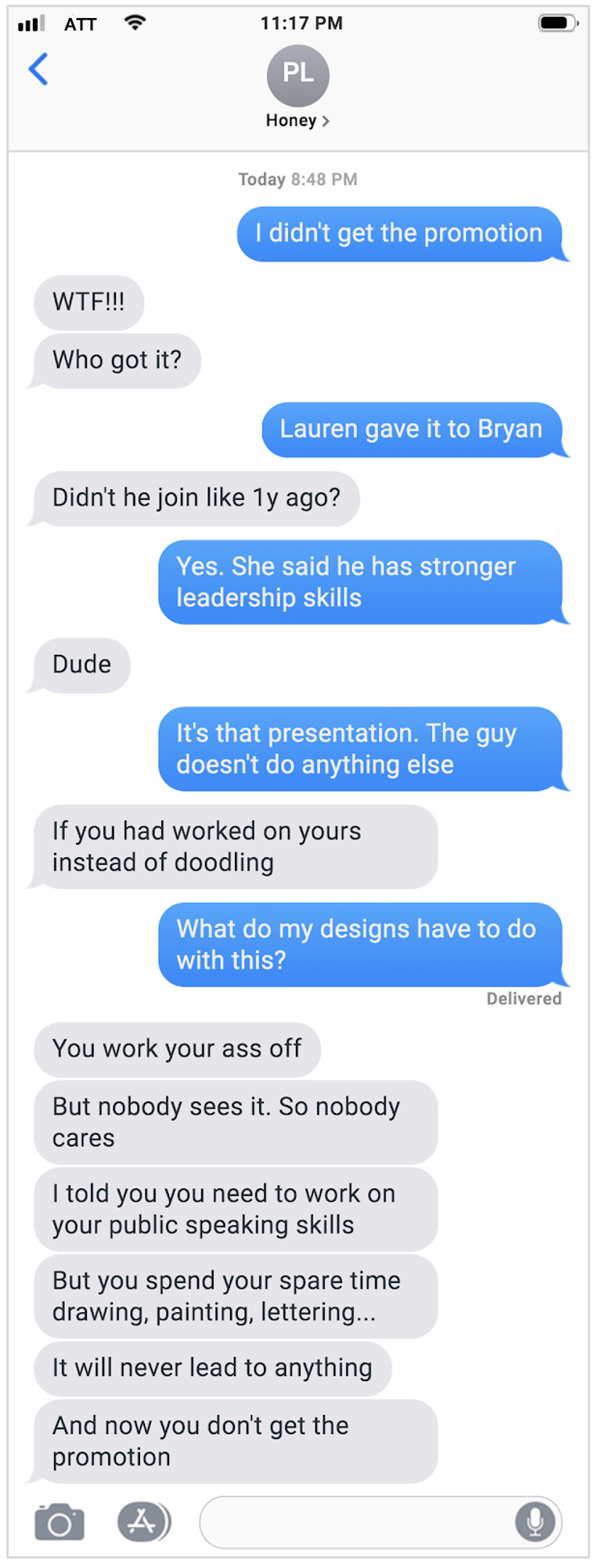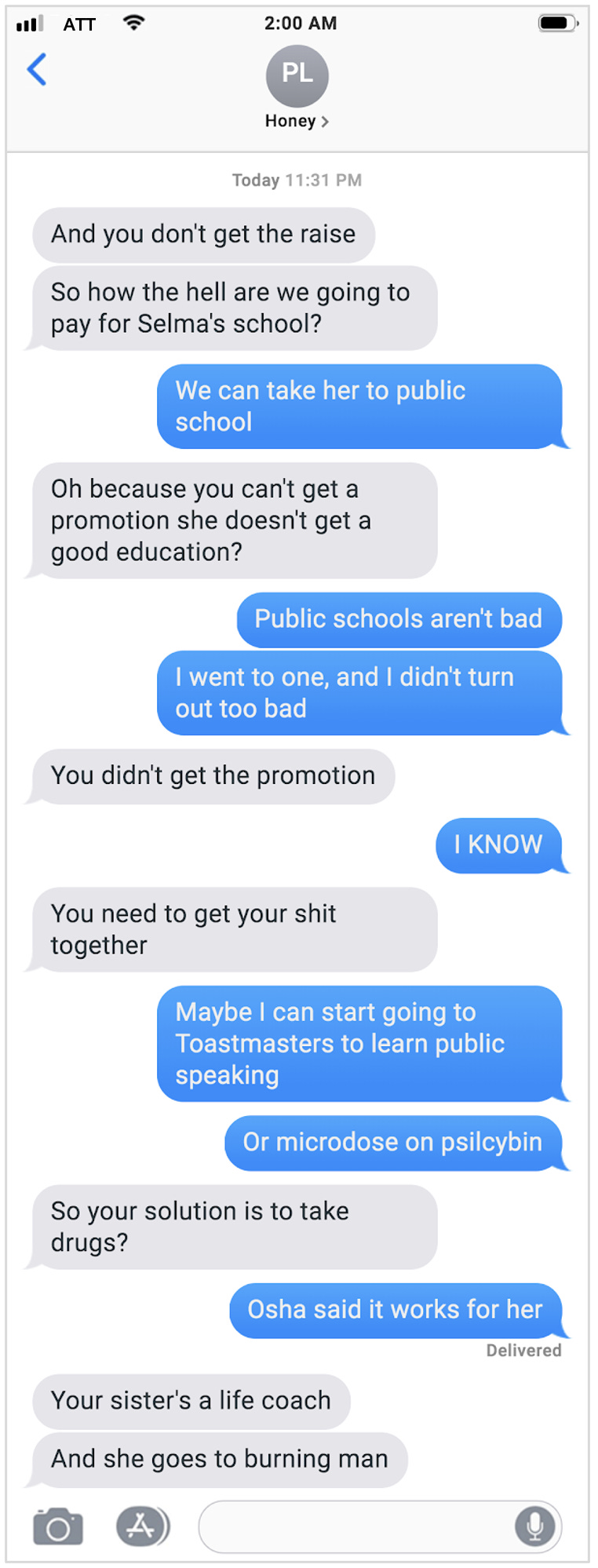How to Make Your Conversations Hyperproductive: 3D Conversation
Have you ever been part of a project that drags indefinitely?
Do meetings linger eternally?
Do they rathole?
Do you leave them with a feeling that little was accomplished?
Do you leave with clear takeaways, only to realize days later that others had concluded something completely different?
At the root of many of these issues is bad conversation flow management.
What Is Conversation Flow?
Imagine this conversation.
What’s this conversation about? A couple talking about the promotion one of them didn’t get. But if you watch closer, it’s much more than that:
This diagram shows the flow of the conversation. The blue lines reflect when the conversation was about the promotion and how to get promoted. But then there are these other topics that pepper the conversation. The dream career in design. The lack of money. The daughter. The need to choose between public and private school. A philosophical decision to invest in education. Drugs. The sister, who is not very well-respected by the partner….
One-Dimensional Conversations
This is what I call a one-dimensional conversation (1D). It follows a single line through all the topics discussed. It meanders following what one person says and what the interlocutor decides to pick up and discuss further.
Each time somebody latches onto something, he’s steering the conversation in a particular direction out of many potential paths. Depending on what each person latches onto, a million different conversations could unfold. In a conversation, each time somebody speaks is a crossroads. And each crossroads means potential for sidetracks.

This is what our original conversation looks like highlighting the crossroads and sidetracks:
Here in black you can see different topics branching out from the actual conversation. For example, here:
The partner could have taken the bait about the sister, trying to defend the passive-aggressive comment about her lifestyle, but chose wisely, avoided that path, and went back to discussing the design career. The conversation followed this path, but at any given time, it could have gone in a different way.
This is what a 1D conversation does. It follows a single thread through different topics, never leaving this single dimension of a wandering line.
1D conversations are great when you’re hanging out with friends or on a Sunday afternoon with your family: you’re not pursuing any goal. But they’re the bane of productive conversations: If you’re trying to be productive, you can’t just follow where the conversation takes you. At any given time, you need to know whether what you’re discussing is useful and course-correct as you get sidetracked. Otherwise, you’ll take a meandering path to nowhere.
This ability to analyze and discuss the conversation as it unfolds is what I call “meta-conversation”. The next step in meta-conversations is two-dimensional conversations.
Two-Dimensional Conversations
A 2D conversationalist can go back in time to venture onto another branch of the conversation. She knows whether the current topic is relevant or not, whether we need to move on or go back to a previous topic. She remains laser-focused on what is being said and jumps in as soon as the thread starts moving in the wrong direction. In other words, she isn’t bound to the single thread of existing conversation. She can choose a better branch at any moment.
In this example, Bertha, Megan and Trevor are debriefing about a candidate they just interviewed:

This is what it looks like graphically:
In the middle of the meeting, Megan and Trevor went on a tangent: the interview process. They had pent-up complaints and took advantage of the opportunity to air them. But it completely derailed the meeting.
Five minutes before the end, Bertha realized what was going on: They were rat-holing! She stopped that thread and went back to the main conversation about the candidate to reach their decision.
What was going on in Bertha’s head when she intervened?
She first realized they were running out of time in the meeting. Then, she wondered: Are we achieving our goal? What is our goal, by the way? When she remembered it, she realized the group was not talking about it, and backtracked into the main conversation. That was great.
What’s Great About 2D Conversations
2D conversationalists are always thinking at two levels:
The normal 1D conversation level: What is being said?
The 2D level: How does that fit into the flow of the conversation?
They don’t just follow the conversation. They also track the meta-conversation.
Doing this well is a sign of intelligence, because you must listen to what is being said, processing it and judging it. But at the same time you need to keep in mind a full picture of what has been said, while labeling the different parts of the conversation according to their flow and worth. That is hard to do all at once.
But it’s worth it, because it dramatically improves the productivity of meetings. Everything that people say is being assessed in real time and cut short if it’s not useful.
Is this all we can do? No.
Despite Bertha’s ability to reroute the meeting, she still wasted a lot of time. Because of the rat-hole, the team couldn’t spend all the time they needed on Janice. They then quickly touched on the last theme—culture fit—in a way that was biased and irrelevant, but by then the earlier conversation wasn’t as fresh. Nobody made the effort to remember the many positive points that had been said about her earlier on, so in the end, they did not make an offer, which was likely a mistake.
What could Beth have done better? Be a 3D conversationalist.
Three-Dimensional Conversations
Let’s summarize. The 1D communicator only follows the present conversation.
It’s ideal for personal conversations, for example, when you’re in the moment, when you want to be fully present. But what happens when the current topic is exhausted and there’s an awkward silence? The 2D conversationalist can save the day.
2D communicators keep in mind at least some pieces of the entire conversation and where it branched. They can go back to these branches to correct the course and achieve the goal. If the current conversation branch is exhausted, they remember where the previous branch was and get back into an interesting conversation. In summary, they can navigate up and down the flow to take other paths.
The 3D conversationalist doesn’t just go back and forth in the flow of a conversation. At any given moment, he knows exactly where he is in the conversation, where it’s going, what the topics that must be touched on are, why things are being said. He’s not just aware of the paths not taken. He can also imagine where the conversation should go. He can picture all the paths that the conversation should take and keep tabs on the most important ones.
For example, imagine a question from a candidate to a recruiter: “How can the company beat the competition?”
If the recruiter was a 1D communicator, she might go down the path of: “Because we’re bigger than the competition.”
A 2D communicator might also do that and then realize that she might not have fully answered the candidate’s question. She might ask: “Does that answer your question?” to open the possibility to go back and take a different path in the conversation.
Instead, a 3D conversationalist would realize that there’s plenty of information about the candidate’s concerns in this question:
He has looked into the competition and is concerned about it.
He did not call out specific competitors. That might mean he doesn’t know the competitive landscape well.
He doesn’t understand the strategy of the company enough to understand how it is meant to beat the competition.
He doesn’t know whether the company is equipped to execute against that strategy.
Anybody might have these options in mind, but only 3D conversationalists will remember they need to touch on all of them:
RECRUITER:That’s a great question. It sounds to me like you have several questions under that, so let me rephrase them and you tell me if those are your questions:
Who are the main competitors and what does the market’s landscape look like?
What’s the company’s strategy in that context?
How is that a winning strategy against the competition?
Is this what I’m hearing from you?
CANDIDATE:Yes, that’s right.
ME: OK, let me address each point sequentially, and then I’ll give you a few minutes to react. For the first point, I will need to go far away, but I’ll then come back to the answer. The second point will take a few minutes, but once it’s clear, the third point will be obvious.
3D communicators don’t just go back to where the conversation branched out, like a 2D communicator. Instead, it’s like the conversation is a chess board, and they are floating on top of it, analyzing the flow of the conversation, predicting where it’s going, and managing that flow.
You can imagine how 3D conversations are more productive than 1D or 2D conversations: They project where to go in the conversation and harvest everything in their wake.
I hope you liked this week’s free article! This first month, I’m trying to give you a taste of the types of topics and articles that you might expect from me. Later this week, the premium article will go deeper in this topic:
How specifically 3D conversations help you achieve your goals.
How the dimensions change depending on the type of conversation: big groups, personal vs. professional…
How to become a 3D communicator.
And more examples to illustrate these concepts.














Great article, thanks! will you talk about cognitive load/metacognition next and how it could influence your ability to have a meta representation of the conversation itself? In any case, I am looking forward to read the next article on this topic.
This was an interesting topic. I liked the graphical representation of the various conversations. The rat-hole graphic explained itself nicely.
I got biased by the first sentence, thinking this was about work productivity exclusively.
Instead, this could be about being a better conversationalist, a better listener, a better ...
And used the workplace conversation as illustrative.
Overall, a great refresher and informational tool to be thoughtful, focused, and listening when in a conversation.